CHAPTER V
Beginning Your Workout
We use the word “workout” loosely here because, as we’ve pointed out, yoga is
less workout and more mind-body exploration. Workout implies sweating as you
push your body into exercise mode. That isn’t what yoga is about.
So, here’s a good way to start your yoga plan. Do these exercises in the order
given for a good beginning workout.
Easy Pose
Begin with the easy pose. Easy pose is a comfortable seated position for
meditation. This pose opens the hips, lengthens the spine and promotes
grounding and inner calm. Basically, you’re sitting cross legged like you did in
school as a young child. “Criss cross apple sauce”, as my teacher used to say!
With the buttocks on the floor, cross your legs and place your feet directly below
your knees. Rest your hands on your knees with the palms facing up. Press your
hip bones down into the floor and reach the crown of the head up to lengthen the
spine. Drop your shoulders down and back and press your chest towards the
front of the room.
Relax your face, jaw, and belly. Let your tongue rest on the roof of your mouth
just behind your front teeth. Breathe deeply through the nose down into the
belly and hold as long as is comfortable.
Downward-Facing Dog
After the easy pose, move into downward-facing dog. This is one of the most
widely recognized yoga poses. Downward-Facing Dog is an all-over, rejuvenating
stretch.
Benefits include:
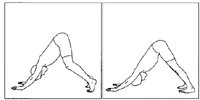
Calms the brain and helps relieve stress and mild depression
Energizes the body
Stretches the shoulders, hamstrings, calves, arches, and hands
Strengthens the arms and legs
Helps relieve the symptoms of menopause
Relieves menstrual discomfort when done with head supported
Helps prevent osteoporosis
Improves digestion
Relieves headache, insomnia, back pain, and fatigue
Therapeutic for high blood pressure, asthma, flat feet, sciatica, sinusitis
Use caution doing this pose if you have carpal tunnel syndrome, are in the late
stages of pregnancy, or suffer from high blood pressure.
Come onto the floor on your hands and knees. Set your knees directly below
your hips and your hands slightly forward of your shoulders. Spread your palms,
index fingers parallel or slightly turned out, and turn your toes under.
Exhale and lift your knees away from the floor. At first keep the knees slightly
bent and the heels lifted away from the floor. Lengthen your tailbone away from
the back of your pelvis and press it lightly toward the pubis. Against this
resistance, lift the sitting bones toward the ceiling, and from your inner ankles
draw the inner legs up into the groins.
Then with an exhalation, push your top thighs back and stretch your heels onto
or down toward the floor. Straighten your knees but be sure not to lock them.
Firm the outer thighs and roll the upper thighs inward slightly. Narrow the front
of the pelvis.
Firm the outer arms and press the bases of the index fingers actively into the
floor. From these two points, lift along your inner arms from the wrists to the
tops of the shoulders. Firm your shoulder blades against your back then widen
them and draw them toward the tailbone. Keep the head between the upper
arms; don't let it hang.
Stay in this pose anywhere from 1 to 3 minutes. Then bend your knees to the
floor with an exhalation and rest.
Sun Salutations
On days when you think you have no time for yoga, try and do at least one or two
rounds of the Sun Salutation. You'll feel the difference.
After downward-facing dog, move into 3 rounds of sun salutations. Stand facing
the direction of the sun with both feet touching. Bring the hands together, palm-
to-palm, at the heart. Inhale and raise the arms upward. Slowly bend backward,
stretching arms above the head. Exhale slowly bending forward, touching the
earth with respect until the hands are in line with the feet, head touching knees.
Inhale and move the right leg back away from the body in a wide backward step.
Keep the hands and feet firmly on the ground, with the left foot between the
hands. Raise the head. While exhaling, bring the left foot together with the
right.
Keep arms straight, raise the hips and align the head with the arms, forming an
upward arch. Exhale and lower the body to the floor until the feet, knees, hands,
chest, and forehead are touching the ground. Inhale and slowly raise the head
and bend backward as much as possible, bending the spine to the maximum
While exhaling, bring the left foot together with the right. Keep arms straight,
raise the hips and align the head with the arms, forming an upward arch. Inhale
and move the right leg back away from the body in a wide backward step.
Keep the hands and feet firmly on the ground, with the left foot between the
hands. Raise the head. Exhale slowly bending forward, touching the earth with
respect until the hands are in line with the feet, head touching knees.
Inhale and raise the arms upward. Slowly bend backward, stretching arms above
the head. Stand facing the direction of the sun with both feet touching. Bring the
hands together, palm-to-palm, at the heart.

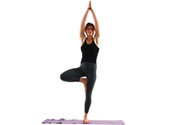
The sequence will look something like this:
Tree Pose - Vriksha Asana
Benefits include:
Strengthens thighs, calves, ankles, and spine
Stretches the groins and inner thighs, chest and shoulders
Improves sense of balance
Relieves sciatica and reduces flat feet
Use caution if you suffer from insomnia or low blood pressure. If you have high
blood pressure, do not raise your arms above your head.
Stand with the feet together and the arms by your sides. Bend the right leg at
the knee, raise the right thigh and bring the sole of the right foot as high up the
inside of the left thigh as possible.
Balancing on the left foot, raise both arms over the head, keep the elbows unbent
and join the palms together. Hold the posture while breathing gently through
the nostrils for about 10 complete breaths.
Lower the arms and right leg and return to the tad-asana, standing position with
feet together and arms at the sides. Pause for a few moments and repeat on the
opposite leg. Do this two or three times per leg or as long as is comfortable.
The challenge of the vriksha-asana is maintaining balance on one leg. Poor
balance is often the result of a restless mind or distracted attention. Regular
practice of this posture will help focus the mind and cultivate concentration
( dharana).
When practicing vriksha-asana it may help to imagine or picture a tree in the
mind and apply the following technique: Imagine that the foot you are balanced
on is the root of the tree and the leg is the trunk.
Continue by imagining the head and outstretched arms as the branches and
leaves of the tree. You may be unsteady for a while and find the body swaying
back and forth, but don't break the concentration. Like a tree bending in the
wind and yet remaining upright, the body can maintain balance.
Aim to achieve the "rootedness" and firmness of a tree. Regular practice of the
vriksha-asana improves concentration, balance and coordination. Because the
weight of the entire body is balanced on one foot, the muscles of that leg are
strengthened and toned as well.
As you advance in this posture and are able to remain standing for more than a
few moments, try closing the eyes and maintaining your balance.
Extended Triangle Pose
Benefits include:
Stretches and strengthens the thighs, knees, and ankles
Stretches the hips, groins, hamstrings, and calves; shoulders, chest, and
spine
Stimulates the abdominal organs
Helps relieve stress
Improves digestion
Helps relieve the symptoms of menopause
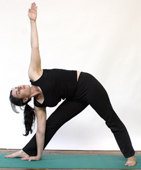
Relieves backache, especially through second trimester of pregnancy
Therapeutic for anxiety, flat feet, infertility, neck pain, osteoporosis, and
sciatica
Use caution if you suffer from low blood pressure, have a heart condition, or
have neck problems.
Stand with the feet together and the arms by your sides. Separate the feet
slightly further than shoulder distance apart. Inhale and raise both arms
straight out from the shoulders parallel to the floor with the palms facing down.
Exhale slowly while turning the torso to the left, bend at the waist and bring the
right hand down to the left ankle. The palm of the right hand is placed along the
outside of the left ankle. The left arm should be extended upward. Both legs and
arms are kept straight without bending the knees and elbows.
Turn the head upward to the left and gaze up at the fingertips of the left hand.
Inhale and return to a standing position with the arms outstretched. Hold this
position for the duration of the exhaled breath. Exhale and repeat on the
opposite side.
The triangle pose is basically doing slow toe touches while concentrating on your
breathing and stretching your body.
Seated Forward Bend – Paschimottanasana
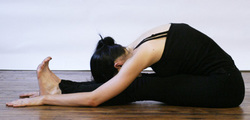
Literally translated as "intense stretch of the west," Paschimottanasana can help
a distracted mind unwind.
Benefits include:
Calms the brain and helps relieve stress and mild depression
Stretches the spine, shoulders, hamstrings
Stimulates the liver, kidneys, ovaries, and uterus
Improves digestion
Helps relieve the symptoms of menopause and menstrual discomfort
Soothes headache and anxiety and reduces fatigue
Therapeutic for high blood pressure, infertility, insomnia, and sinusitis
Traditional texts say that Paschimottanasana increases appetite, reduces
obesity, and cures diseases.
Use caution if you suffer from asthma or have a back injury.
Sit on the floor with your buttocks supported on a folded blanket and your legs
straight in front of you. Press actively through your heels. Rock slightly onto
your left buttock, and pull your right sitting bone away from the heel with your
right hand. Repeat on the other side.
Turn the top thighs in slightly and press them down into the floor. Press through
your palms or finger tips on the floor beside your hips and lift the top of the
sternum toward the ceiling as the top thighs descend.
Draw the inner groins deep into the pelvis. Inhale, and keeping the front torso
long, lean forward from the hip joints, not the waist. Lengthen the tailbone away
from the back of your pelvis. If possible take the sides of the feet with your
hands, thumbs on the soles, elbows fully extended; if this isn't possible, loop a
strap around the foot soles, and hold the strap firmly. Be sure your elbows are
straight, not bent.
When you are ready to go further, don't forcefully pull yourself into the forward
bend, whether your hands are on the feet or holding the strap. Always lengthen
the front torso into the pose, keeping your head raised.
If you are holding the feet, bend the elbows out to the sides and lift them away
from the floor; if holding the strap, lighten your grip and walk the hands
forward, keeping the arms long. The lower belly should touch the thighs first,
then the upper belly, then the ribs, and the head last.
With each inhalation, lift and lengthen the front torso just slightly; with each
exhalation release a little more fully into the forward bend. In this way the torso
oscillates and lengthens almost imperceptibly with the breath. Eventually you
may be able to stretch the arms out beyond the feet on the floor.
Stay in the pose anywhere from 1 to 3 minutes. To come up, first lift the torso
away from the thighs and straighten the elbows again if they are bent. Then
inhale and lift the torso up by pulling the tailbone down and into the pelvis.
Bound Angle Pose - Baddha Konasana
Bound Angle Pose, also called Cobbler's Pose after the typical sitting position of
Indian cobblers, is an excellent groin and hip-opener.
Benefits include:
Stimulates abdominal organs, ovaries and prostate gland, bladder, and
kidneys
Stimulates the heart and improves general circulation
Stretches the inner thighs, groins, and knees
Helps relieve mild depression, anxiety, and fatigue
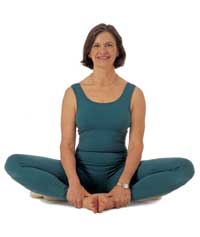
Soothes menstrual discomfort and sciatica
Helps relieve the symptoms of menopause
Therapeutic for flat feet, high blood pressure, infertility, and asthma
Consistent practice of this pose until late into pregnancy is said to help
ease childbirth.
Traditional texts say that Baddha Konasana destroys disease and gets rid
of fatigue.
Sit with your legs straight out in front of you, raising your pelvis on a blanket if
your hips or groins are tight. Exhale, bend your knees, pull your heels toward
your pelvis, then drop your knees out to the sides and press the soles of your feet
together. Bring your heels as close to your pelvis as you comfortably can. With
the first and second finger and thumb, grasp the big toe of each foot. Always
keep the outer edges of the feet firmly on the floor. If it isn't possible to hold the
toes, clasp each hand around the same-side ankle or shin.
Sit so that the pubis in front and the tailbone in back are equidistant from the
floor. The perineum then will be approximately parallel to the floor and the
pelvis in a neutral position. Firm the sacrum and shoulder blades against the
back and lengthen the front torso through the top of the sternum.
Never force your knees down. Instead release the heads of the thigh bones
toward the floor. When this action leads, the knees follow. Stay in this pose
anywhere from 1 to 5 minutes. Then inhale, lift your knees away from the floor,
and extend the legs back to their original position.
Wide-Angle Seated Forward Bend - Upavistha Konasana
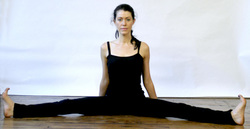
Upavistha Konasana is a good preparation for most of the seated forward bends
and twists, as well as the wide-leg standing poses
Benefits include:
Stretches the insides and backs of the legs
Stimulates the abdominal organs
Strengthens the spine
Calms the brain
Releases groins
Use caution with this exercise if you have a lower back injury.
Sit with your legs extended out in front of you, then lean your torso back slightly
on your hands and lift and open your legs to an angle of about 90 degrees (the
legs should form an approximate right angle, with the pubis at the apex). Press
your hands against the floor and slide your buttocks forward, widening the legs
another 10 to 20 degrees. If you can’t sit comfortably on the floor, raise your
buttocks on a folded blanket.
Rotate your thighs outwardly, pinning the outer thighs against the floor, so that
the knee caps point straight up toward the ceiling. Reach out through your heels
and stretch your soles, pressing though the balls of the feet.
With your thigh bones pressed heavily into the floor and your knee caps pointing
up at the ceiling, walk your hands forward between your legs. Keep your arms
long.
As with all forward bends, the emphasis is on moving from the hip joints and
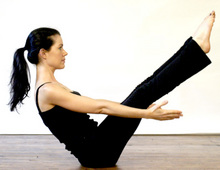
maintaining the length of the front torso. As soon as you find yourself bending
from the waist, stop, re-establish the length from the pubis to the navel, and
continue forward if possible.
Increase the forward bend on each exhalation until you feel a comfortable
stretch in the backs of your legs. Stay in the pose 1 minute or longer. Then come
up on an inhalation with a long front torso.
Full Boat Pose
An abdominal and deep hip flexor strengthener, Boat Pose requires you to
balance on the tripod of your sitting bones and tailbone.
Benefits include:
Strengthens the abdomen, hip flexors, and spine
Stimulates the kidneys, thyroid and prostate glands, and intestines
Helps relieve stress
Improves digestion
Use caution if you have low blood pressure, insomnia, neck problems, are
pregnant or menstruating.
Sit on the floor with your legs straight in front of you. Press your hands on the
floor a little behind your hips, fingers pointing toward the feet, and strengthen
the arms. Lift through the top of the sternum and lean back slightly. As you do
this make sure your back doesn't round; continue to lengthen the front of your
torso between the pubis and top sternum. Sit on the "tripod" of your two sitting
bones and tailbone.
Exhale and bend your knees, then lift your feet off the floor, so that the thighs
are angled about 45-50 degrees relative to the floor. Lengthen your tailbone into
the floor and lift your pubis toward your navel. If possible, slowly straighten
your knees, raising the tips of your toes slightly above the level of your eyes. If
this isn't possible remain with your knees bent, perhaps lifting the shins parallel
to the floor.
Stretch your arms alongside the legs, parallel to each other and the floor. Spread
the shoulder blades across your back and reach strongly out through the fingers.
If this isn't possible, keep the hands on the floor beside your hips or hold on to
the backs of your thighs.
While the lower belly should be firm, it shouldn't get hard and thick. Try to keep
the lower belly relatively flat. Press the heads of the thigh bones toward the floor
to help anchor the pose and lift the top sternum. Breathe easily. Tip the chin
slightly toward the sternum so the base of the skull lifts lightly away from the
back of the neck.
At first stay in the pose for 10-20 seconds. Gradually increase the time of your
stay to 1 minute. Release the legs with an exhalation and sit upright on an
inhalation.
Bridge Pose
This active version of Bridge Pose calms the brain and rejuvenates tired legs.
Benefits include:
Stretches the chest, neck, and spine
Calms the brain and helps alleviate stress and mild depression
Stimulates abdominal organs, lungs, and thyroid
Rejuvenates tired legs
Improves digestion
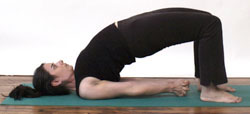
Helps relieve the symptoms of menopause
Relieves menstrual discomfort when done supported
Reduces anxiety, fatigue, backache, headache, and insomnia
Therapeutic for asthma, high blood pressure, osteoporosis, and sinusitis
Use caution if you have a neck injury.
Lie supine on the floor, and if necessary, place a thickly folded blanket under
your shoulders to protect your neck. Bend your knees and set your feet on the
floor, heels as close to the sitting bones as possible.
Exhale and, pressing your inner feet and arms actively into the floor, push your
tailbone upward toward the pubis, firming (but not hardening) the buttocks, and
lift the buttocks off the floor. Keep your thighs and inner feet parallel. Clasp the
hands below your pelvis and extend through the arms to help you stay on the
tops of your shoulders.
Lift your buttocks until the thighs are about parallel to the floor. Keep your
knees directly over the heels, but push them forward, away from the hips, and
lengthen the tailbone toward the backs of the knees. Lift the pubis toward the
navel.
Lift your chin slightly away from the sternum and, firming the shoulder blades
against your back, press the top of the sternum toward the chin. Firm the outer
arms, broaden the shoulder blades, and try to lift the space between them at the
base of the neck (where it's resting on the blanket) up into the torso.
Stay in the pose anywhere from 30 seconds to 1 minute. Release with an
exhalation, rolling the spine slowly down onto the floor.

Legs-Up-the-Wall Pose - Viparita Karani
Said to reverse the normal downward flow of a precious subtle fluid called
amrita (immortal) or soma (extract) in the Hatha Yoga Pradipika, modern yogis
agree that Viparita Karani may have the power to cure whatever ails you.
Benefits include:
Relieves tired or cramped legs and feet
Gently stretches the back legs, front torso, and the back of the neck
Relieves mild backache
Calms the mind
The pose described this is a passive, supported variation of the shoulder stand.
For your support you'll need one or two thickly folded blankets or a firm round
bolster. You'll also need to rest your legs vertically (or nearly so) on a wall or
other upright support.
Before performing the pose, determine two things about your support: its height
and its distance from the wall. If you're stiffer, the support should be lower and
placed farther from the wall; if you're more flexible, use a higher support that is
closer to the wall.
Your distance from the wall also depends on your height: if you're shorter move
closer to the wall, if taller move farther from the wall. Experiment with the
position of your support until you find the placement that works for you.
Start with your support about 5 to 6 inches away from the wall. Sit sideways on
right end of the support, with your right side against the wall (left-handers can
substitute "left" for "right" in these instructions). Exhale and, with one smooth
movement, swing your legs up onto the wall and your shoulders and head lightly
down onto the floor.
The first few times you do this you may slide off the support and plop down with
your buttocks on the floor. Don't get discouraged. Try lowering the support
and/or moving it slightly further off the wall until you gain some facility with
this movement, then move back closer to the wall.
Your sitting bones don't need to be right against the wall, but they should be
"dripping" down into the space between the support and the wall. Check that the
front of your torso gently arches from the pubis to the top of the shoulders.
If the front of your torso seems flat, then you've probably slipped a bit off the
support. Bend your knees, press your feet into the wall and lift your pelvis off the
support a few inches, tuck the support a little higher up under your pelvis, then
lower your pelvis onto the support again.













